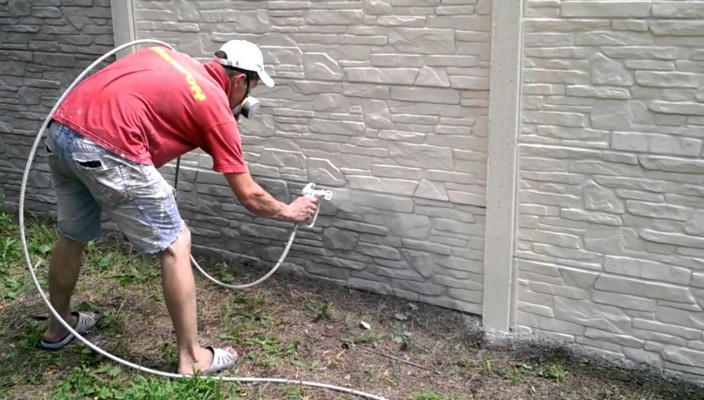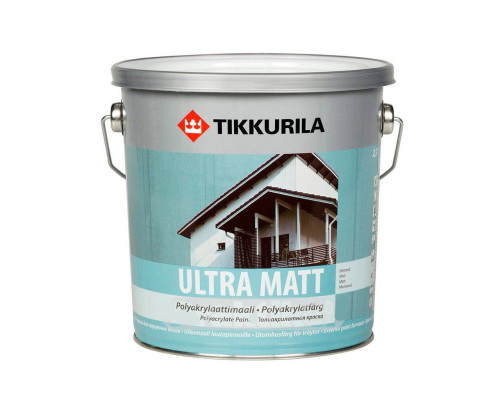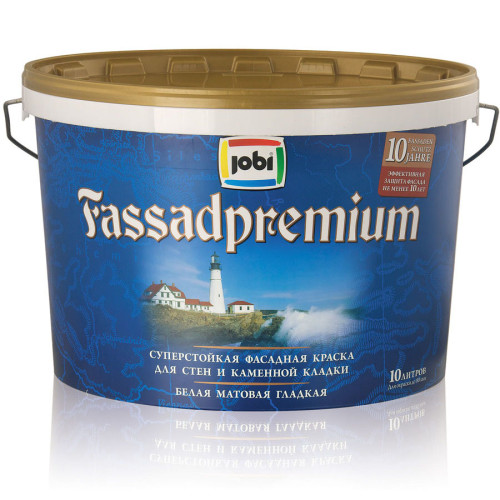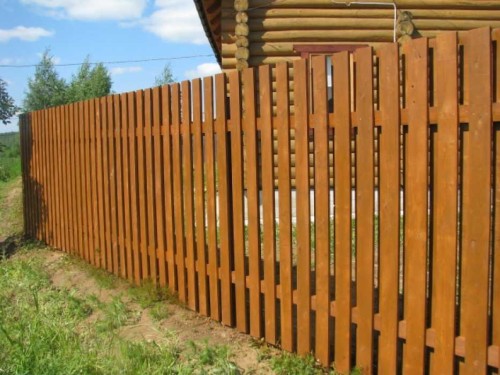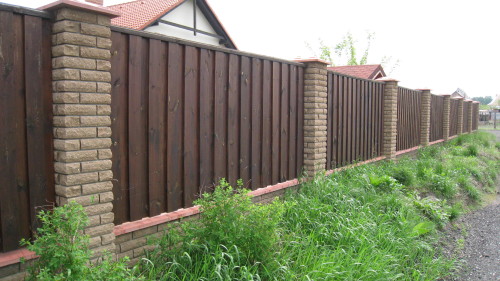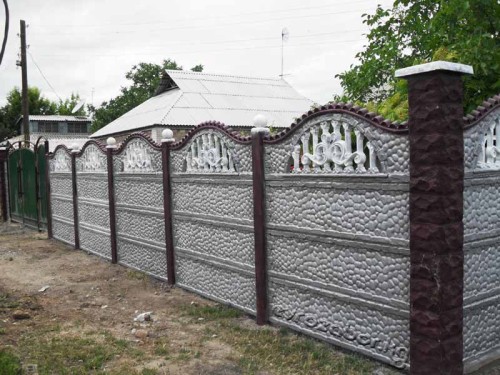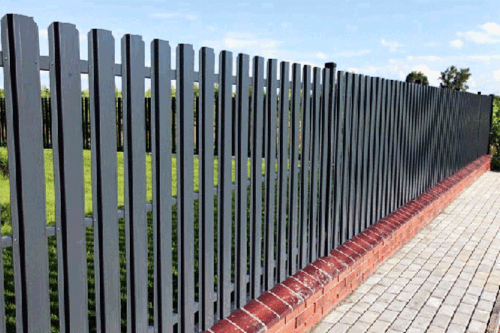The fence is a fencing, the main purpose of which is to protect against ill-friendly guests. But if the design is a little embellish, it will perfectly fit into the surrounding landscape. About the nuances of painting fence and will be discussed in our article.
Content
Requirements for paint
For high-quality staining of the fence, it is necessary to choose the right paint material. In many ways, the choice of the product depends on the material of manufacturing the fence.
Paint for painting a fence made of wood should be resistant to moisture, sun rays and bacteria. The minimum coating service life is 5 years. Moreover, during this period, the paint should not lose its color properties.
For concrete fence, moisture resistance, frost resistance and inconsistency of temperature drops are mandatory requirements. It is also important to concrete coating to give aesthetic appeal.
For fencing from metal, in addition to the above requirements, it is necessary to ensure anti-corrosion protection.
Tikkurila, Caparol and Dufa Fassadenfarbe are possessing the most attractive technical characteristics.
As for the norms of fish consumption, the average is 0.3 ml / 1 m². An increase in the consumption of the material may occur when staining the embossed surface with textural elements.
Selection of material for painting
Painting of a wooden fence can be carried out by alkyd enhalar, oil or acrylic products.
Alkid formulations for fence
Alkyd paints are inexpensive products. Their composition includes the following substances:
- acids;
- alcohol elements;
- components forming the film (oil, resin or olife).
Alkidic compositions are characterized by:
- frost resistance;
- resistant to temperature drops and impact of atmospheric phenomena.
The only nuance - applying alkyd paint is carried out only on well dried wood. In this case, it will be difficult to embody the original ideas of the painting of the fence, as the surface can be covered with bubbles or begin to peel. Effective drying of wood occurs within 8-10 hours.
Oil paint for fence
It is a traditional material for painting wooden coatings. The most economical option for finishing the fence.
Now oil paints are quite rare. And this is despite the fact that the painted surface is characterized by excellent resistance to atmospheric precipitation. The "minuses" of using oil materials is:
- long duration of drying (24-28 hours);
- the probability of sweating surface after some time.
Acrylic products for fence
This paintwork is the most popular. This is explained by the fact that the paint has a water base. Acrylate acts as a binder component, due to which a reliable grip of paint is achieved with a surface.
Acrylic paints are universal products. They are suitable for staining the fence made of any material. In addition, the popularity of paint is explained by the fact that it does not close the pores, allowing you to "breathe" the coating.
The painting of the fence (in the photo) acrylic paint is the best solution for finishing a wooden surface, which becomes resistant to the wet environment, frost and the scorching sunshine. Due to a variety of assortment, there is an opportunity to make the surface of any color.
Acrylic paints are characterized by:
- lack of inclination under application;
- high resistant mechanical load;
- excellent wear resistance;
- long operational period.
Acrylic paint material is a good solution for staining the fence of metal. Such a coating is a reliable corrosion protection.
Latex and silicone formulations for fence
A more expensive option for painting the fence is the use of latex or silicone paint.
Latex paints are made of liquid glass. They can add aluminum or zinc that make the composition of anti-corrosion. Such products are suitable for staining metal fences.
For latex paints, deep penetration of the painted surface is characterized. Even if it is made of concrete. But it should be noted that when painting a concrete fence will take a lot of paintwork.
The basis of the manufacture of silicone paint is silicate and acrylic. This material is the most resistant to the appearance of fungus or mold. He perfectly withstands the temperature differences.
Universal paint for fence
This material is good because its application does not provide for the preparation of the surface to paint. Universal paints include anti-corrosion components.
Their application is carried out on the metal fence. And this can be done directly on rust. The universal composition protects the metal from further destruction. Such paints are ideal for finishing fencing from ferrous metal, steel or reinforced concrete.
Despite this, experts recommend cleaning the surface from dirt and old coating. On the metal fence, walk emery paper and is projected, and the wooden fence is covered with an antiseptic agent.
Metallic fence
Painting metal fences rarely costs without the use of primer, which is designed for mechanical protection of the coating from the wet environment. There are various primers:
- Glyphthalve. Covered the fence to which oil paint will be applied.
- Phenoloformaldehyde. These compositions are used when staining enamel paint fences.
- Phosphate. Improve adhesion qualities. When applied, diluted with acid components.
The primer can be done at home. For this make a mixture consisting of:
- dense iron suice (55%);
- natural olifa (20%);
- zinc bleel (15%);
- turpidar (8%);
- siccaty (2%).
Antiseptic for fence
When painting a wooden fence, an antiseptic is necessarily used. It will eliminate the fencing from mold and fungus, premature rotting and insects.
Antiseptic tools are coated and lesing. The first materials are opaque. When applying the coating antiseptics, wood is completely hidden. The lesing agent leaves the tree natural shades.
Paint and Color for the fence
As for color, the fence can be painted both in cold tones (green or blue) and warm (yellow or orange). The only requirement is the fence must be harmonized with the surrounding landscape.
Pretty stylish will look a fence, which in color coincides with the roofing material of the house. The bottom can be made a little darker top.
It should be noted that glossy paint emphasizes the existing defects, and matte, on the contrary, hides them. For this reason, the glossy material is quite rare.
One of the options for painting the fence with a smooth surface is the application of the texture composition. This material changes relief design. In addition, the texture paint is the best coating, which is not necessarily the negative effects of moisture and temperature fluctuations.
Painting wooden structures
For dyeing any surface, you should decide on the tool. There are three main options:
- brush;
- roller;
- kraspopult.
Tassel is a necessary tool. And this is despite the fact that such a way of painting is the longest and time consuming. Tassel must be made of natural bristles. Artificial material will constantly fall out and glued to the surface. And this will spoil the appearance of the coating.
Of course, you can use and roller (it will reduce time on painting). But without brushes, do not do in hard-to-reach places.
Painting the fence of the paintopult will make the process as fast as possible and high-quality. The only nuance is to acquire additional equipment (compressor).
The process of painting a wooden fence provides:
- cleaning the surface from dirt, dust and cobwebs;
- removal of sandpaper jar and protruding knots;
- wood processing by antiseptic;
- applying to the fence of the primer layer (or waterproof paint);
- drying primer;
- coating the fence of the main paint.
The staining process starts in the upper part of the fence, gradually moving down. In order not to be withdrawal, you do not need to impose a thick layer.
Application of paint on concrete fences
Naturally, the concrete fence of gray color causes a sense of depression. Its painting can solve this problem. But not only for this, the fence is painted. Paint protects fence from mechanical exposure.
The best options are green (with a fencing of a section with growing greens), blue (next to the pool or reservoir) and brown colors (when the fence is placed from a brick house) with their shades.
If the concrete fence is located on the side where the sun's rays fall, the process of staining is better to carry out matte material. Glossy paint shines too much. It should also be noted that painting with light paint will visually increase the fence, and when painting in dark tones, a visual decrease in the design will occur.
The process of painting a concrete fence consists of such steps:
- cleaning the surface from dust and other contaminants with a damp brush with a rigid pile (you can use a soap solution, the washout of which is produced by water pressure);
- processing anti-grapple mixture of places where there is a high probability of mold appearance;
- applying an anti-corrosion agent on the elements of the fence made of metal;
- sealing all cracks with concrete solution;
- similar to the surface (it is recommended that the primer and paint manufacturer is one);
- coating a structure 2-3 layers of paint (after drying the primer).
To apply the first layer of paint, it is better to use the roller (except in cases with a relief surface). Due to this, the paint layer will last much longer than when applied by the paint. Inaccessible places are painted with a brush.
After complete drying of the first layer, the second layer is applied. Now you can use the spray gun. Before each painting concrete fence, paint must be mixed thoroughly. Only so you can achieve a homogeneous color of the coating.
If paint is purchased with high vapor permeability, then a special waterproofing mixture is applied before applying the primer. Thus, the creation of a protective layer occurs, due to which the moisture will not fall into the pores of the fence.
The concrete fence will look quite original, painted "under the stone":
- with the help of a pencil and ruler, the surface markup is carried out and figures are applied to it;
- at the joints of the "stones" paste a painting tape;
- unclosed ribbon surface is painted;
- after drying paint, the paint ribbon is removed.
Coloring metal fences
Metal fence is painted almost identically with wooden and concrete structures. The only distinctive feature is increased surface preparation requirements. The quality of it depends on how much the protection of metal from corrosion will be ensured.
In most cases, the usual black metal is used for the manufacture of fences. For this reason, before painting, the surface is necessarily subjected to priming.
The procedure for painting a metal fence involves the following actions:
- the surface of the brush is cleaned from rust, dirt and old coating;
- galvanized design is treated with ammonia solution;
- black metal is covered with primer;
- the base paint is applied to the design of non-ferrous metal, which binds oxidized particles;
- after drying the primer / basic paint, the main paint material is applied.
To clean the surface, you can use:
- metal wire brush;
- emery paper;
- steel spatula;
- cleaners.
But there is a more effective way. It consists in using a soldering lamp or oxygen-acetylene burner. Due to this, the full combustion of old paint and peeling the whole rust occurs.
Before applying, the paint is thoroughly mixed. To get a new shade, you can mix multiple paints. Moreover, the mixing cannot be subjected to various types of material and diluted formulations. Also do not breed the paint too much solvent. This composition creates a subtle and transparent layer.
As for the use of a specific tool, it depends on the type of metallic fencing:
- If there is a smooth and large area, a roller or ankopult is used.
- If bars are the main elements of the fence, then a flat tassel with a bristle medium rigidity should be used.
- There is another option using aerosol cans. It is acceptable to paint a small fencing.
Video about painting the fence:

